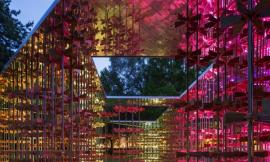SCI-Arc students build affordable home in low-income Los Angeles neighbourhood
由专筑网Yumi,Vigo编译
南加州建筑学院的学生在洛杉矶一个犯罪率较高的地区完成了一个结合建造的设计项目。该项目的特点包括让居住者感觉到“安全感”。
住宅名为IVRV,与 Greater Los Angeles的人类栖息地分会(一个为有需要的人建造房屋的非盈利组织)合作建造的。
该建筑位于一个犯罪率高的低收入社区——West Athens,这片地由洛杉矶县捐赠。除去捐赠的劳动力和建筑材料,该建筑每平方英寸花费165美元(112英镑)。
Students in a design-build program at the Southern California Institute of Architecture have completed a house in a crime-ridden area of Los Angeles, with features included to help occupants feel "safe and secure".
Called the IVRV House, the dwelling was built in collaboration with the Greater Los Angeles chapter of Habitat for Humanity, a nonprofit organisation that constructs homes for those in need.
The home is located in West Athens, a crime-ridden and low-incomeneighbourhood, and was built on land donated by LA County. Excluding donated labour and materials, the house was constructed for $165 per square foot (£112).
这个两层的建筑总面积1185平方英尺(110平方米),包含三个卧室和两个设备齐全的浴室。该住宅采用木框架结构,结构包覆在捐赠的水泥板之中,住宅顶端是一个山形的屋顶。
不透明的正立面上部的体块被削掉一大块,这样可以让阳光进入一层的中庭以及上层的阳台和卧室。
Encompassing 1,185 square feet (110 square metres), the two-storey home contains three bedrooms and two full bathrooms.
Topped with a gabled roof, the wood-framed dwelling is clad in cement boards, which were donated.
The front facade is opaque, with the exception of large cuts in the upper portion – enabling daylight to steam into an entry courtyard on the ground level – and a balcony and bedroom on the upper floor.
Darin Johnstone是一个设计工作室的教授,同时负责南加州建筑学院的这个洛杉矶的人居项目。据其所说,倾斜的建筑后端是为了增厚墙体以添加保温层,以及为嵌入的窗提供遮阳。
建筑两侧立面部分被包在幕墙中,幕墙可将光线和空气引入中庭和停车场,也有防盗的作用。
“很多附近的房子都在地界线围了栏杆,窗户上也装了栅栏。”Johnstone说。
The rear of the house is tilted in order to "thicken the wall for added insulation and to provide shading for the inset windows," said Darin Johnstone, a design studio professor who heads the SCI-Arc/Habitat LA Housing Project.
The sides of the building are partially sheathed in screens that bring light and air into the courtyard and a carport, while also protecting the home from intruders.
"So many of the houses in the neighbourhood have fences on the front property line and bars on the windows," said Johnstone.
“我们想在建筑被削去的体块中营造一个受保护的室外区域,这样家庭成员就可以置身其中充分享受加州的气候、享受加州人的生活方式,并拥有安全感。”
立面遮阳板被该设计团队称为“生态幕墙”,同样具有环保效益。
外层由黑色的外部金属板组成,设计它用于容纳薄的光伏电池板。内层由乙烯基片组成,它被覆盖了光催化材料,这种基片可捕捉并中和空气中的有害颗粒。这些幕墙层被粘在具有结构作用的铁管状框架上。
"We wanted to create a protected outdoor area within the gabled volume of the house, so the family can enjoy the full benefits of the California climate and lifestyle while feeling safe and secure."
The brise-soleils, referred to as "eco-screens" by the design team, also have environmental benefits.
The outer layer consists of black exterior metal panels that are designed to accommodate thin photovoltaic panels. The inner layer is made of vinyl strips coated in a photocatalyst material that captures and neutralises harmful particulates in the air.The layers are affixed to a steel tube structural frame.
该建筑的室内布局紧凑,一层包括了开敞式厨房和客厅,还有一个小化妆室。
“厨房区域有两层高,充分利用了高倾斜空间的优势,让透过窗墙的南向阳光深透地渗入建筑内部空间。”该团队说。
Inside, the home features a compact layout. The first floor contains an open-plan kitchen and living room, along with a small powder room.
"The kitchen area is double height, taking full advantage of the tall gabled space and allowing the southern light from the window wall to penetrate deep into the spaces of the house," the team said.
第二层房子布置了卧室、设备齐全的浴室和一个可俯瞰入口区域的、用玻璃围成的通廊。
该住宅已被Belete Belhu购买,他是一位出生在埃塞俄比亚的美国陆军老兵,住宅的具体售价未知。Belhu和他的家人也帮忙建造了这栋住宅。该住宅是在南加州建筑学院三组工作室的课程中设计而成,该课程旨在探索价廉、可持续的当代住宅设计。本来最初共提出了十组方案,通过复审后敲定了最终方案。
The second storey houses the bedrooms, full bathrooms and a glass-enclosed corridor that overlooks the entry court.
The home has been purchased for an undisclosed amount by Belete Belhu, a US Army veteran who was born in Ethiopia. Belhu and his family helped construct the dwelling.
The house was designed over the course of three studios at SCI-Arc that explored affordable, sustainable and contemporary residential design. Ten schemes were initially proposed, with a final scheme chosen through a juried review.
之后修建的住宅在一个研讨会课程期间。
“我们尝试去挑战可持续经济住宅内容与形式的现状,”Johnstone说。他指出团队注重创造一个适应West Athens地区的方案。
The home was then constructed during a seminar course.
"We tried to challenge the status quo of sustainable and affordable housing in form and content," said Johnstone.
He noted that the team focused on creating a solution that was appropriate for West Athens.
“在这个缺少历史的社区,我们为这个家庭建造的不仅是一个安全、经济、可持续的房子,它也同样是一所可爱而迷人的房子。”他说。
南加州建筑学院和Habitat LA在2014年开始合作,他们旨在构思一个“重新开发洛杉矶被忽视的建筑,并积极影响其所在的社区的创新型方针。”
"In this historically challenged neighbourhood, we tried to produce a house for the family that is not only safe, affordable and sustainable but also delightful, alluring and hopefully beautiful," he said.
SCI-Arc and Habitat LA began working together in 2014, in an effort to conceive "innovative ways to redevelop neglected properties in LA and positively impact the communities they exist within".
IVRV是他们第一个建成的项目。这个名字的来源于据Johnstone所说的想法:“颠覆住宅类型学——颠覆惯例的功能性关系。”该项目的其他贡献者包括通用汽车基金会、Bernards建筑公司以及洛杉矶县第二区。
The IVRV House is their first completed project. Its name stems from the idea of "turning the residential typology inside out – inverting and reversing convention functional relationships," said Johnstone.
Other contributors to the project included the General Motors Foundation, the construction company Bernards and LA County's Second District.
“南加州建筑学院一直坚信设计可以改变世界,这些学生已经通过建造一座结合可持续、智能材料和新型经济建筑系统的房子来证明这一点。”学校副主任John Enright说道。
南加州建筑学院有一片位于洛杉矶市中心艺术区的校园用地,这里以前是一个货运站。目前这里有500名学生和80名教职工。
"SCI-Arc has always believed that design can change the world, and these students have proven that by building a house that incorporates sustainability, smart materials and novel economic building systems," said John Enright, the school's vice director.
SCI-Arc's campus occupies a former freight depot in LA's Downtown arts district. It currently has 500 students and 80 faculty members.
美国其它的“学生设计+建造项目”包括:耶鲁建筑系学生为低收入小区家庭设计的临时住宅;以及科罗拉多州丹佛大学学生完成的其位于犹他州的纳瓦霍印第安人保留地的小木屋, 。
摄影:Joshua White
Other student design-build projects in the US include a contemporary family home in a low-income neighbourhood by Yale architecture students and a pair of micro cabins on the Navajo Reservation in Utah by architecture students at the University of Colorado Denver.
Photography is by Joshua White.
Ground floor plan/底层平面图
First floor plan/二层平面图
项目信息
指导:Darin Johnstone
学生领导:Howard Chen
获胜的设计团队:Deysi Blanco, Howard Chen and Sarah Mark
Student design, development and construction team: Deysi Blanco, Louie Bofill, Leonora Bustamante, Renso Caicedo, Rome Cao, Howard Chen, Yufan Chen, Hussam Al Dabiani, Jennifer Diep, Eliad Dorfman, Elliot Freeman, Adam Fujioka, Meldia Hacobian, Sungmi Hyun, Thomas Leglu, Sylvia Liu, Ayla Malka, Sarah Mark, Kazi Maysun, Lu Cheng Pan, Jin Park, Yixiong Peng, Noni Pittenger, Jiamin Shou, Cathy Qu, Breeze Xue
学生研讨会建设团队:Sara Abalkhail, Renso Caicedo, Robert Davidsun, Coleman Griffin, Zhaoji Luo, Xueyang Lyu, Trenton Allan Mays, Saba Nasehi, Nairi Nancy Nayirian, Carol Ann Paden, Uriel Quevedo
结构工程师:Nous Engineering – Matthew Melnyk, principal and Stephanie Miyata
MEP工程师:Ctl-e
Project credits:
Instructor: Darin Johnstone
Student lead: Howard Chen
Winning design team: Deysi Blanco, Howard Chen and Sarah Mark
Student design, development and construction team: Deysi Blanco, Louie Bofill, Leonora Bustamante, Renso Caicedo, Rome Cao, Howard Chen, Yufan Chen, Hussam Al Dabiani, Jennifer Diep, Eliad Dorfman, Elliot Freeman, Adam Fujioka, Meldia Hacobian, Sungmi Hyun, Thomas Leglu, Sylvia Liu, Ayla Malka, Sarah Mark, Kazi Maysun, Lu Cheng Pan, Jin Park, Yixiong Peng, Noni Pittenger, Jiamin Shou, Cathy Qu, Breeze Xue
Student seminar construction team: Sara Abalkhail, Renso Caicedo, Robert Davidsun, Coleman Griffin, Zhaoji Luo, Xueyang Lyu, Trenton Allan Mays, Saba Nasehi, Nairi Nancy Nayirian, Carol Ann Paden, Uriel Quevedo
Structural engineer: Nous Engineering – Matthew Melnyk, principal and Stephanie Miyata
MEP engineer: Ctl-e
出处:本文译自www.dezeen.com/,转载请注明出处。
|
|

 ArchTriumph 竞赛的“活力展馆”在博物馆花园公开展览
ArchTriumph 竞赛的“活力展馆”在博物馆花园公开展览
